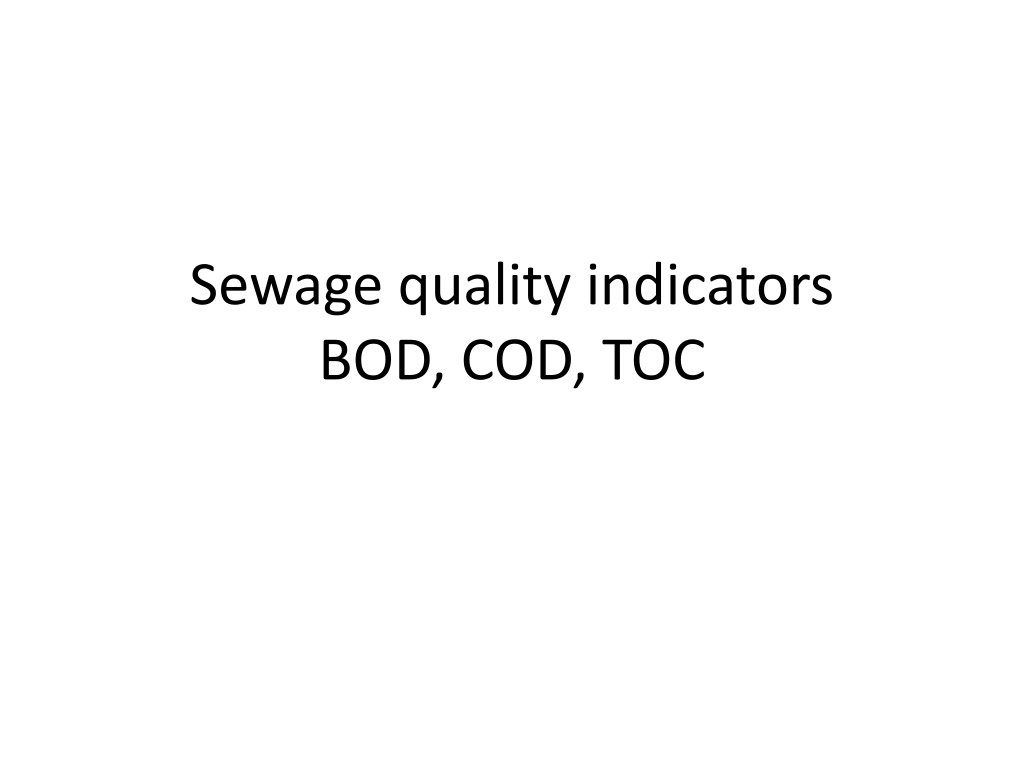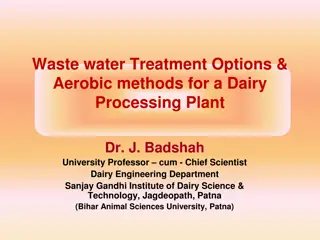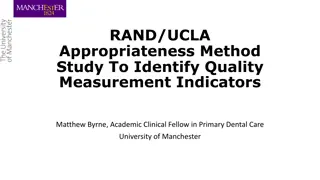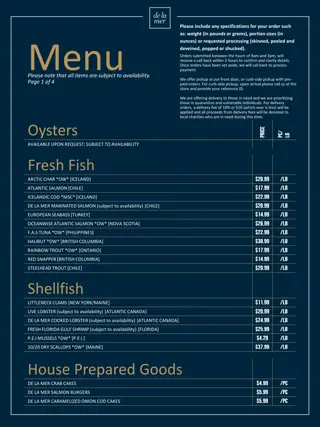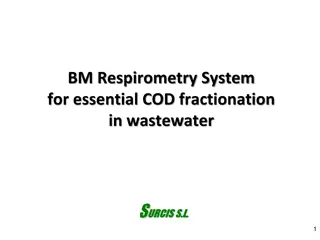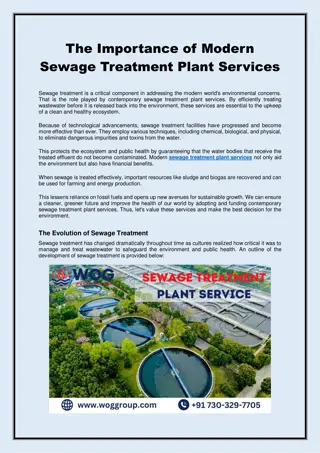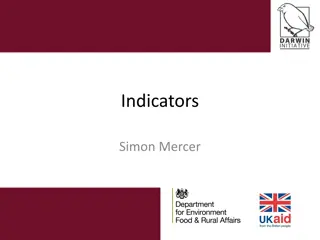Sewage Quality Indicators: BOD, COD, TOC
Sewage quality indicators such as BOD, COD, and TOC play a crucial role in assessing the characteristics of sewage. Explore the physical, chemical, and biological constituents of sewage, as well as biodegradable organics and Biochemical Oxygen Demand (BOD). Understand how bacteria utilize organic materials, measure BOD values, and the importance of the BOD reaction speed.
Uploaded on Feb 25, 2025 | 0 Views
Download Presentation

Please find below an Image/Link to download the presentation.
The content on the website is provided AS IS for your information and personal use only. It may not be sold, licensed, or shared on other websites without obtaining consent from the author.If you encounter any issues during the download, it is possible that the publisher has removed the file from their server.
You are allowed to download the files provided on this website for personal or commercial use, subject to the condition that they are used lawfully. All files are the property of their respective owners.
The content on the website is provided AS IS for your information and personal use only. It may not be sold, licensed, or shared on other websites without obtaining consent from the author.
E N D
Presentation Transcript
Sewage quality indicators BOD, COD, TOC
Characteristics of sewage: 1. Physical characteristics: deals with color, odor, temperature. 2. Chemical Characteristics: a. Inorganic constituents: Its concentrations depend on water use. Inorganic constituent may be not removed by treatment such as chlorides, sulfur, heavy metals .etc. b. Organic constituents: include those present in sewage such as fats, proteins, carbohydrate, etc. c. Gases: Hydrogen sulfide, methane, oxygen, NH3, CO2, N2. 3. Biological constituents : Viruses, plants, worms, protozoans.
Biodegradable organics: Biodegradable materials consist of organics that can be utilized for food buy naturally occurring microorganisms within a reasonable length of time. In dissolved form, these materials usually consist of starches, fats, proteins, alcohols and others. Microbial utilization of dissolved organics is accompanied by oxidation process.
Biochemical Oxygen Demand (BOD): Bacterial placed in contact with organic material will utilize it as a food source. In the utilization process, the organic matter will eventually be oxidized to stable end products such as CO2and water. The amount of oxygen used in this process is called the Biochemical Oxygen Demand and is considered to be a measure of the organic content of the wastewater. The BOD determination has been standarized to measure the amount of oxygen utilized by microorganisms in the stabilization of wastewater for 5 days at 20 C0. For domestic sewage, the 5 day value or BOD5represents approximately 2/3 of the demand which would be exerted if all the biologically oxidizable material were in fact oxidized.
??? = ? (1 ??1?) Where: BOD: the oxygen utilized by the bacteria from the beginning to the time (t) L: the amount of oxygen required to oxidize all the organics(BODU) t: time K1: constant. For wastewater use, value of K1at 20 CO= 0.230/day. EX: Find 1 day BOD and BODU , If 5 day BOD at 20 C0= 200 mg/L. use k1=0.23/day.
EX: Find BODU and 1 day BOD, If 5 day BOD at 20 C0= 200 mg/L. use k1=0.23/day. Sol. ??? = ? (1 ? ?1?) 200 = ? (1 ? 0.23 5) L = 294 mg/L ??? = 294 (1 ? 0.23 1) BOD = 60 mg/L.
The value of k determines the speed of the BOD reaction. Value of k range from 0.1 to 0.5 / day depending on the nature of the organic molecules, simple compounds such as sugar and starch are easily utilized by the microorganisms and have a high k rate while complex molecules such as phenols are difficult to utilized and have low k. The value of k for any given organic compound is temp- dependent. Because microorganisms are more active at higher temperature, the value of temperature. k increases with increasing
??= ?20?(?20) A value of 1.047 for ? is often used although ? is known to vary somewhat with temperature ranges. EX/ The BOD5of a wastewater is determined to be 150 mg/L at 20 C0. The K value is known to be 0.23 / day. What would the BOD5be if the test were run at 15 C0? Sol: 150 = ? (1 ? 0.23 5) L = 220 mg/L
Correct the k value for 15 C0 ??= ?20?(? 20) ?15= 0.23 1.047 5 ?15= 0.18/day Calculate BOD5at 15 C0 ??? = 220 (1 ? 0.23 5) BOD5= 130 mg/l
Chemical Oxygen Demand (COD): The COD test is used to measure the content of organic matter in wastewater that contains compounds that are toxic to biological life. No clear correlation exists between BOD and COD in general but at a specific treatment plant a correlation is possible. For untreated domestic waste BOD5/ COD ratio varies from (0.4) (0.8) and COD value varies from 250 1000 mg/L. Chemical oxidation of organics.
